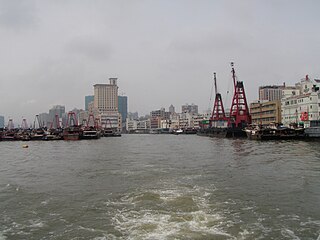
Hong Kong has a highly developed and sophisticated transport network, encompassing both public and private transport. Based on Hong Kong Government's Travel Characteristics Survey, over 90% of the daily journeys are on public transport, the highest rate in the world. However, in 2014 the Transport Advisory Committee, which advises the Government on transportation issues, issued a report on the much worsened congestion problem in Hong Kong and pointed at the excessive growth of private cars during the past 10–15 years.

Transport in Macau includes road, sea, rail and air transport. Road transport is the primary mode of transport within Macau, although a new rail system opened in December 2019 serving the areas of Taipa and Cotai. The main forms of public transport are buses and taxis.

Macau International Airport is an international airport in the special administrative region of Macau, situated at the eastern end of Taipa island and neighbouring waters which opened for commercial operations on 9 November 1995, during Portuguese administration of the region.

Zhuhai, also known as Chuhai is a prefecture-level city located on the west bank of Pearl River estuary on the central coast of southern Guangdong province, People's Republic of China, on the southeastern edge of Pearl River Delta. Its name literally means "pearl sea", which originates from the city's location at the mouth of the Pearl River meeting the South China Sea. Zhuhai borders Jiangmen to the west, Zhongshan to the north and Macau to the southeast, and shares maritime boundaries with Shenzhen and Hong Kong to the northeast across the estuary.

A border checkpoint is a location on an international border where travelers or goods are inspected and allowed passage through. Authorization often is required to enter a country through its borders. Access-controlled borders often have a limited number of checkpoints where they can be crossed without legal sanctions. Arrangements or treaties may be formed to allow or mandate less restrained crossings. Land border checkpoints can be contrasted with the customs and immigration facilities at seaports, international airports, and other ports of entry.

The Port of Hong Kong, located by the South China Sea, is a deepwater seaport dominated by trade in containerised manufactured products, and to a lesser extent raw materials and passengers. A key factor in the economic development of Hong Kong, the natural shelter and deep waters of Victoria Harbour provide ideal conditions for berthing and the handling of all types of vessels. It is one of the busiest ports in the world, in the three categories of shipping movements, cargo handled and passengers carried.
Ká Hó Port is one of two ports in Macau, China. It is located on Ilha de Coloane.

The Port of Zhuhai is the port of the prefecture-level city of Zhuhai, on the west side of the Pearl River estuary in the Chinese province of Guangdong. The Port of Zhuhai is composed of seven main port areas: Gaolan, Wanshan, Jiuzhou, Xiangzhou, Tangjia, Hongwan and Doumen. The main areas are the Jiuzhou Port Area to the east of the city, and the Gaolan Port Area to the west. As of 2012, the port had 131 berths, 126 production berths, of which 17 were deep-water berths over 10,000DWT.

The Port of Shenzhen is a collective name of a number of ports along parts of the coastline of Shenzhen, Guangdong Province, China. These ports as a whole forms one of the busiest and fastest growing container ports in the world.
Articles related to Macau include:
The Port of Qingdao is a seaport on the Yellow Sea in the vicinity of Qingdao (Tsingtao), Shandong Province, People's Republic of China. It is one of the ten busiest ports in the world.

The Taipa Ferry Terminal is located in Taipa, Macau SAR.

Skypier is a cross-border ferry pier integrated within Hong Kong International Airport, Chek Lap Kok, New Territories, Hong Kong. It is operated by Hong Kong International Airport Ferry Terminal Services Limited, a joint-venture company between Chu Kong Passenger Transport Co., Ltd and Shun Tak-China Travel Ship Management Limited. At this pier, passengers aboard can transit from Hong Kong International Airport to piers in the Pearl River Delta of Guangdong Province or vice versa, without immigration and customs clearance through Hong Kong.

Zhuhai railway station, also known as Gongbei station (拱北站), is an elevated station of the Guangzhou–Zhuhai intercity railway. It is located in the Gongbei Subdistrict (jiedao) of Xiangzhou in Zhuhai, Guangdong, China, besides the Gongbei Port and parallel to the border between mainland China and Macau. The station is the southern terminus of the Guangzhou–Zhuhai intercity railway and the northern terminus of the Zhuhai–Zhuhai Airport intercity railway.

The Port of Macau is the seaport of Macau, China.

Shekou is an area at the southern tip of Nanshan District, Shenzhen, Guangdong Province, China. It faces Yuen Long, Hong Kong across the Shenzhen Bay. It has been designated as a Free Trade Zone by the government, alongside Qianhai, Hengqin and Nansha New Area.

Shekou Cruise Center, also known as the Shekou Ferry Terminal and the Shekou Prince Bay Cruise Homeport, is a cruise terminal located in Shekou, Nanshan District, Shenzhen, China. It runs direct ferry connections from Shenzhen to destinations across the Pearl River Delta. It is operated by China Merchants Shekou Ferry Terminal Service Co., Ltd. Ferry operations are operated by Xunlong Ferries, TurboJET and CKS Ferries. It can also handle cruise ships docking and replenishment, and is the first cruise terminal in China. This facility replaces the former Shekou Passenger Terminal and is part of a larger urban renewal and redevelopment along Shenzhen Bay.

The Guangdong–Hong Kong–Macau Greater Bay Area also referred as the Greater Bay Area (GBA), is a megalopolis, consisting of nine cities and two special administrative regions in South China. It is envisioned as an integrated economic area aimed at taking a leading role globally by 2035.















